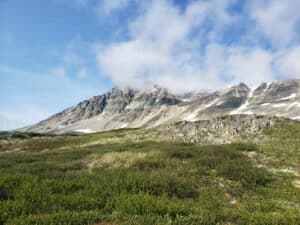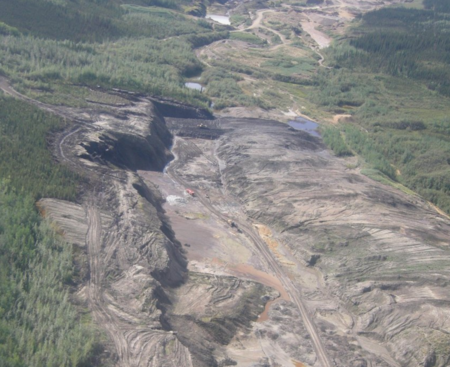Wetlands Protection – for peats sake!
Sebastian Jones – Fish, Wildlife and Habitat Analyst, Yukon Conservation Society

Photo by / par Conor Curtis
This story is from our friends at the Yukon Conservation Society and was part of their January Tread Lightly Newsletter. Since 1968, the Yukon Conservation Society has been advocating, educating, and conducting research on Yukon environmental issues. You can read the full edition of that newsletter here.
It’s a truism that if you present your problem to government, their response is to make it disappear – which is not at all the same as solving the problem or even directly addressing it.
Our current Yukon government definitely takes this approach, and the ‘Policy for the stewardship of Yukon’s wetlands’ is a classic example.
“Yukon government’s policy for the stewardship of wetlands has not applied a protection first approach to wetlands.”
– Tr’ondëk Hwëch’in and Na-Cho Nyäk Dun First Nation
Before we dive in, a light refresher on wetlands:
Most wetlands are located in low-lying areas (because water runs downhill) which also happen to be places where placer gold is deposited (because gold also moves down-hill) and are considered ideal areas for development and extraction.
“Wetlands support cultural uses and activities such as hunting, trapping, and fishing.”
Yukon’s wetlands are amoung our most biodiverse set of ecosystems.
Wetlands are disappearing globally; they are drained for housing and farms, they are mined for peat and minerals, and our ongoing greenhouse gas emissions are warming the land so much that some wetlands are drying up.
Now, let us return to Yukon government’s problem:
It has a duty to protect the environment, and it is pressured to do so by bodies such as YCS and First Nations, who have nurtured wetlands for countless generations. At the same time, it thinks it has a duty to promote mining – and gold miners find a lot of gold underneath wetlands.
In an attempt to make this problem go away, at least for a while, it recently released the wetlands policy.
So, has it succeeded? Is the pressure off government? Are wetlands better protected now than before the policy was adopted?
Perhaps?!
Government can certainly point to the policy as a basis for how to approach wetlands, with the overall goal being to sustain the benefits of Yukon’s wetlands, which isn’t the same as protecting them.
The policy defines wetland benefits as:
“the ecological and cultural benefits that result from the specific characteristics of a wetland and the processes occurring within the wetland; including hydrological, biophysical and chemical benefits, as well as benefits to people.”
Thus far, no mechanism for measuring wetland benefits was described within the policy. However, seeing as wetlands had zero protection before the policy came out, anything is an improvement on nothing.
But… How is everyone feeling about it thus far?
The Yukon Chamber of Mines appears to broadly support it. Life is probably a bit harder for placer miners in particular, who have few options other than to mine wetlands. So, they are likely not very happy.
As wetlands are not actually protected by the policy, First Nations and conservation communities are not very happy either. In fact, the Tr’ondëk Hwëch’in and Na-Cho Nyak Dun have publicly called for the policy to be withdrawn.
“We have always advocated for a protections first approach, acknowledging the rarity and significance of these important ecosystems on the land. We have also always asked that our role as managers of resources within our traditional territory be emphasized through the co-development and joint approval of the policy. We did not see this happen, and we now find ourselves with a final policy approved by Yukon Government alone that has not honoured the spirit and intent of our Final Agreement.”
– Chief Joseph, Tr’ondëk Hwëch’in First Nation“We call on Yukon government to rescind the policy and to return to the table with a commitment to truly co-developing a new wetlands policy that respects our treaty rights and protects the waters and wetlands of our territory for our future generations.”
– Chief Mervyn, Na-Cho Nyäk Dun First Nation
So, by this metric, government might have failed to put its problem to bed. And given how many contentious issues in the policy have been left for further development as the policy is implemented, the wetlands file looks set to give government headaches for some time to come.
There are some potentially good things in the policy:
· Peat mining is off the table (but nobody really mines peat in the Yukon)
· A new quasi-protected legal designation of Wetlands of Special Importance
(but no Specially Important Wetlands are identified)
· Commitments to map and classify Yukon’s wetlands
· It acknowledges that activities outside of a wetland can affect a wetland.

The Policy seems to leave several matters for later,
including guidelines for restoring peatlands and for offsetting unrestored wetlands.
Offsets are where wetlands are created, or degraded wetlands are ‘restored’ to make up for the destruction or degradation of natural wetlands.
Of course, peatlands cannot be ‘restored’, no more than a tree can be ‘restored’- they need to grow, and similar to a tree, they do not reach their full potential for a long time – decades for trees, but centuries for peatlands.
So, YCS shall continue to engage on the Wetlands Policy for some time to come.
We will participate and strive for the most robust protection for these special places, and promise to keep you in the loop as the wetland story continues to unfold.
